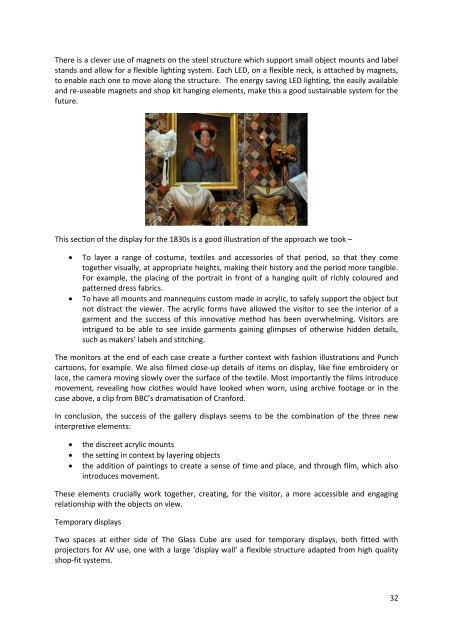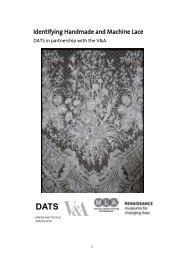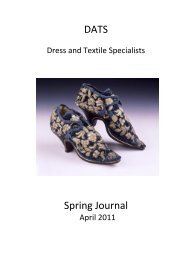Spring 2012 - Dress and Textile Specialists
Spring 2012 - Dress and Textile Specialists
Spring 2012 - Dress and Textile Specialists
Create successful ePaper yourself
Turn your PDF publications into a flip-book with our unique Google optimized e-Paper software.
There is a clever use of magnets on the steel structure which support small object mounts <strong>and</strong> label<br />
st<strong>and</strong>s <strong>and</strong> allow for a flexible lighting system. Each LED, on a flexible neck, is attached by magnets,<br />
to enable each one to move along the structure. The energy saving LED lighting, the easily available<br />
<strong>and</strong> re-useable magnets <strong>and</strong> shop kit hanging elements, make this a good sustainable system for the<br />
future.<br />
This section of the display for the 1830s is a good illustration of the approach we took –<br />
<br />
<br />
To layer a range of costume, textiles <strong>and</strong> accessories of that period, so that they come<br />
together visually, at appropriate heights, making their history <strong>and</strong> the period more tangible.<br />
For example, the placing of the portrait in front of a hanging quilt of richly coloured <strong>and</strong><br />
patterned dress fabrics.<br />
To have all mounts <strong>and</strong> mannequins custom made in acrylic, to safely support the object but<br />
not distract the viewer. The acrylic forms have allowed the visitor to see the interior of a<br />
garment <strong>and</strong> the success of this innovative method has been overwhelming. Visitors are<br />
intrigued to be able to see inside garments gaining glimpses of otherwise hidden details,<br />
such as makers’ labels <strong>and</strong> stitching.<br />
The monitors at the end of each case create a further context with fashion illustrations <strong>and</strong> Punch<br />
cartoons, for example. We also filmed close-up details of items on display, like fine embroidery or<br />
lace, the camera moving slowly over the surface of the textile. Most importantly the films introduce<br />
movement, revealing how clothes would have looked when worn, using archive footage or in the<br />
case above, a clip from BBC’s dramatisation of Cranford.<br />
In conclusion, the success of the gallery displays seems to be the combination of the three new<br />
interpretive elements:<br />
<br />
<br />
<br />
the discreet acrylic mounts<br />
the setting in context by layering objects<br />
the addition of paintings to create a sense of time <strong>and</strong> place, <strong>and</strong> through film, which also<br />
introduces movement.<br />
These elements crucially work together, creating, for the visitor, a more accessible <strong>and</strong> engaging<br />
relationship with the objects on view.<br />
Temporary displays<br />
Two spaces at either side of The Glass Cube are used for temporary displays, both fitted with<br />
projectors for AV use, one with a large ‘display wall’ a flexible structure adapted from high quality<br />
shop-fit systems.<br />
32





